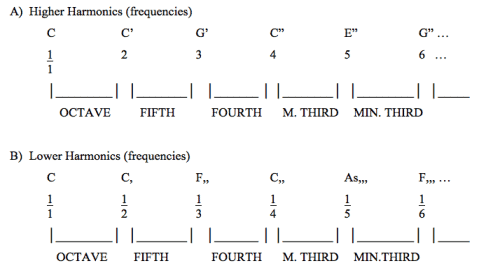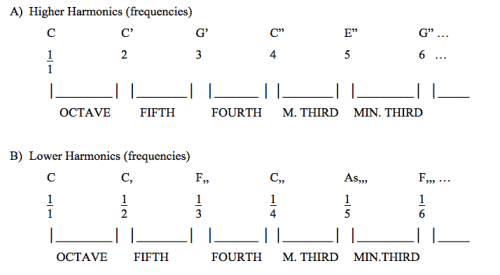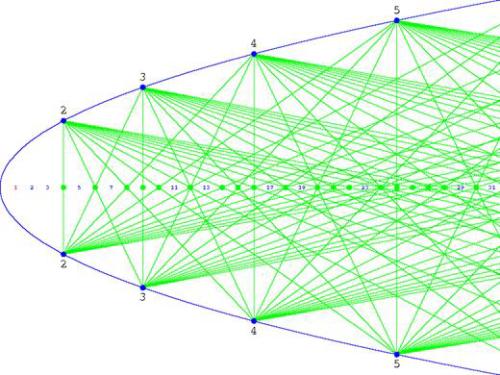 “To vibrate with the rhythm of the Cosmos means to realize all the majesty of the Infinite. … That is why Our harmonies are so potent. The fire of the centres is harmony; the fire of the spirit is harmony; the fire of the heart is harmony.”
“To vibrate with the rhythm of the Cosmos means to realize all the majesty of the Infinite. … That is why Our harmonies are so potent. The fire of the centres is harmony; the fire of the spirit is harmony; the fire of the heart is harmony.”
THE HIGHER AND LOWER HARMONIC SERIES*
At the basis of the whole science of harmonics is a natural, physical law, which has been well known to scientists for centuries but whose value is little understood: any sound, produced in any way, spontaneously generates other sounds, according to a constant order of succession. All these sounds together (which can be physically registered) constitute what is called the series of higher harmonics, whose first values are:
C . C’ . G’ . C” . E” . G” . °B” . C’” ….
It is of great importance to observe that the place occupied by each sound can be numbered, in this way:
C . C’ . G’ . C” . E” . G” . °B” . C’” ….
1 2 3 4 5 6 7 8 …∞
according to the indefinite series of whole, rational, positive numbers: one and one alone of the infinite whole numbers corresponds to each one of the infinite sounds generated by the basic one.
Sound and number remain thus combined, by an incontrovertible natural law: it is enough to indicate a number to identify a sound, and to emit a note to indicate a number. This truth corroborates the already noted correspondence between sound as number and sound as value.
But of even greater importance is the following observation: the numbers which successively define the “place” of the various sounds in the series of the higher harmonics indicate also the frequency of that sound in relation to the frequency of the basic sound, taken as a unit of measurement. For example, the 5th sound, E”, has a frequency 5 times greater than the base sound C; the 3rd, G’, has a frequency 3 times greater than the same, and so on.
This happy, perfect correspondence between sound, position and frequency is certainly one of the most amazing physical laws, both for its simplicity and for its real meaning: it is the experimental confirmation of the indissoluble and natural union between that which is measurable and tangible (number, frequency) and that which is psychic, intangible; between the world of science and that of the psyche; between the sphere of the builder and that of the artist.
What has been said up to now is valid as far as concerns frequencies.
But if the first terms of the series of the superior harmonics are rewritten and are made to correspond to the length of the string which produces them, or to the wavelength of their oscillation in relation to that of the fundamental note, one obtains:
C . C’ . G’ . C” . E” . G” …
1/1 1/2 1/3 1/4 1/5 1/6 1/∞
where the numerical part repeats, in reverse, the order of the preceding part, relative to the temporal aspect, that is frequencies.
Thus there are two possibilities of combining sound with number: according to the frequency (time) and according to the length (space). A law connects them, as has already been seen, through which one passes from one arrangement to the other using this formula:
γ = 1/λ
according to which frequency and wavelength are reciprocal one to another.
***
The harmonic series rise rapidly in frequency, as has been seen, and so they soon pass out of the field of oscillations which are audible to the human ear. It is easy, on vibrating a string, to hear the formation of the first and second harmonic, but the successive ones are rarely perceived. It is a fact that, in reality, they exist physically, and this leads one to affirm that it is really impossible to listen to a pure sound, even if one wished to do so: since there is no sound without harmonics, which vibrate together with it and are inevitably merged with it, composing an extremely complex group of chords: the part of this chord which the ear perceives is that which is accepted as the original sound, but the chord, which in reality remains inaudible, is really quite different.
Moreover, it must be reasonably assumed, on the basis of this physical law, that each of the higher harmonics which have been generated so spontaneously produces, in its turn, innumerable sounds, in observance to the same law, which it must also obey; and so on.
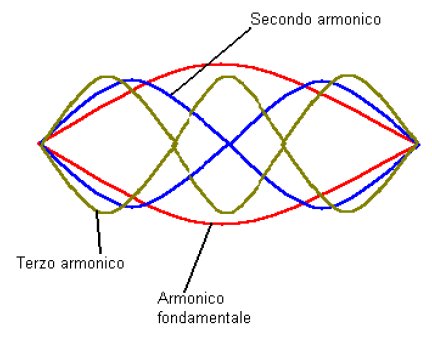 A single sound (as long as it vibrates) starts off an infinite complex of secondary sounds, which certainly condition it and which are its specific progeny. This creation is, however, strictly ordered and the place of each creature rigidly fixed, as well as its form (number) and its psychic quality (value) with respect to the base sound and all the other harmonics.
A single sound (as long as it vibrates) starts off an infinite complex of secondary sounds, which certainly condition it and which are its specific progeny. This creation is, however, strictly ordered and the place of each creature rigidly fixed, as well as its form (number) and its psychic quality (value) with respect to the base sound and all the other harmonics.
These and numerous other considerations, legitimate yet extraordinary, which can be deduced seem to illustrate the truth of that very famous page, at the beginning of the Gospel of St. John, where the equivalence between God and Word, between Spirit and Sound, its creative agent, is affirmed.
And other Writings, held to be sacred by various ancient and modern peoples, concur in presenting to man the image of the Logos (sound) as the creating Demiurge of forms, according to an ordered, precise and predisposed plan.
It was stated in ancient times (Upanishad) that Sound is Fire. In the world of Fire (or of the Spirit) – where everything is one – the law is only one, and its physical repercussion can only be the law of the higher harmonics.
This is why this is to be considered the authentic, legitimate and inconfutable basis of all harmonical speculations. In the beginning a Sound echoes and the worlds arise in an orderly way and the creatures are born in order. And as long as that Sound lasts, the creation is developed and is manifested; in case it should cease, immediately all forms would vanish in absolute quiet. And such a creation is knowable because it is orderly and successive, and a universal order must reign which is also knowable, on the basis of its numerical and quantitative expressions: the material basis (number) reveals the psychical content (the value) and the former produces the latter, without error.
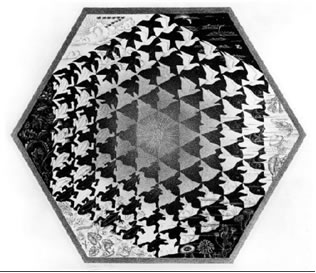 Certainly this conception, irreproachable as it is, calls for a far more attentive examination and more serious verification. But it is the immediate conclusion which one reaches if one contemplates without prejudice the impeccable precision of the correspondence between that which is internal and contained (value, sound) and that which is formal and external (number, quantity).
Certainly this conception, irreproachable as it is, calls for a far more attentive examination and more serious verification. But it is the immediate conclusion which one reaches if one contemplates without prejudice the impeccable precision of the correspondence between that which is internal and contained (value, sound) and that which is formal and external (number, quantity).
***
After the preceding affirmations about the higher series of harmonics, it is legitimate to ask oneself: “do lower harmonics also exist?” In other words: if the higher octave is first generated spontaneously from the original sound and then the fifth and so on, should not the lower octave, the lower fifth and so on, also be produced in the same order? The answer is simple: no-one has ever heard them as yet, no instrument has ever recorded them.
It is as if sound produced only other rising sounds, always higher; as if only these were its real progeny. In this the accuracy of the old proposition proves true, according to which the nature of sound is fiery: like the flame it tends to rise by itself, in order to return to its heavenly dwelling.
However, this does not alter the fact that the lower harmonics are still always a logical possibility, which it is right to take into account. But in the study of harmonics their intrinsic nature is to be understood as illusory, which matches perfectly the physical reality of the higher ones. As a legitimate and orderly whole, they constitute a world without true reality, so to speak; or better still, they obtain their appearance only from the reality of the higher ones, of which they are the reflection.
This said, the “other world” of the lower harmonics is arranged in exactly the opposite way to that of the higher ones, both for values and for numbers. The lower series thus assumes these aspects:
To summarize, the world of the lower harmonics is thus exactly symmetrical to that of the higher ones, but it is without real existence, just as the sun reflected in the water is not the sun which shines in the sky, although it also emanates light and warmth. It is perfectly knowable on the basis of the higher one, whose laws and arrangement it repeats. But it should not be forgotten that it lacks reality, which allows one to presume that even that which is illusory in the Universe is nevertheless orderly so that, by studying it, one can go back to knowing those truths which it reflects.
***
From the examination of the two series of harmonics: the higher, real ones and the lower semblances, emerges an aspect of extreme importance: hierarchical order. The original sound, in fact, produces, in a regular and orderly succession, the intervals arranged in order of importance:
First of all is that interval to which we give the name of Unison; then the Octave appears, then the Fifth, followed by the Fourth, the Thirds, and so on.
Thus in the world of vibrations created by the original Sound not only do exact concordance and correspondence exist between every single sound entity and its numerical expression, but in addition everything is arranged according to a strict hierarchy of values. This is a phenomenon of immense importance, which will be dealt with in future. But for now it is well to note and learn that all that is sound can be likened to the good and the beautiful, is subject to a numerical expression and is moreover arranged in a hierarchical order. It follows, as a first consequence, that where no hierarchy (of values, not of quantity) exists neither goodness nor beauty exist.
***
“Where is the end, and where the beginning? Let us end with this formula: in the infinite chain of harmony.”





